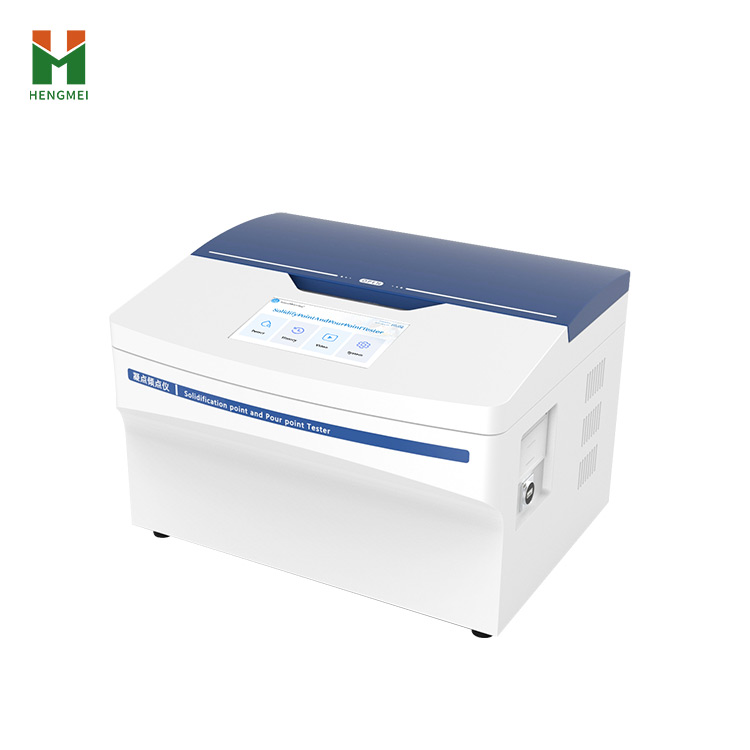In the fields of petrochemicals, lubricant production, and quality testing, the low-temperature flowability of oil products is one of the key indicators, which directly affects the product's performance and environmental adaptability. The accurate determination of pour point and pour point, as core parameters for measuring the low-temperature fluidity of oil products, is of great significance for product quality control, transportation and storage, and terminal applications. The fully automatic pour point analyzer has greatly improved the accuracy and efficiency of measurement through highly automated and intelligent design, and has become an important analytical equipment in modern laboratories.

Core principle: How can automatic pressure method achieve precise measurement?
The core principle of the fully automatic pour point analyzer is based on the automatic air pressure method. Its design and results are consistent with the tilt method described in standards such as GB/T 510, ISO 3016, and ASTM D97, but it achieves automation and objectivity of the process.
The workflow is as follows:
Sample preheating: The instrument automatically heats the sample to 45 ℃ or 9 ℃ above the expected pour point to eliminate its thermal history effect and ensure that all samples are in the same initial state before testing.
Program cooling: Subsequently, the system cools down the program at the specified rate required by the standard. The cooling process is divided into two stages of precise control: when the temperature is higher than the expected pour point/pour point value (EPP)+40 ℃, the cooling rate is maintained at 3-4 ℃/min; When the temperature is below EPP+40 ℃, the rate is precisely controlled at 0.8~1.1 ℃/min to meet the standard requirements for slow cooling near the pour point/pour point.
Interval testing and automatic judgment: Starting from the expected value+15 ℃, the instrument automatically applies a constant pressure of 310Pa to the sample every 1 ℃. The built-in high-precision air pressure sensor monitors pressure changes in real-time within the system. As the sample gradually solidifies and loses its fluidity, its ability to resist gas passage changes, and the instrument accurately captures the critical temperature point at which fluidity is lost, which is the solidification point or pour point value of the sample.
This method avoids subjective errors caused by human observation, making the results more objective and with higher repeatability (repeatability can reach ± 1 ℃).
Technological advantages and solutions to industry pain points
Based on the above principles, modern fully automatic pour point measuring instruments exhibit the following advantages, directly targeting user pain points:
Degree of automation and intelligence
Pain points: Manual testing involves complex steps, high dependence on personnel experience, and low efficiency.
Solution: The entire process from preheating, cooling, testing to result judgment is automatically completed. Adopting a 7-inch high-definition touch screen Android operating system, the interface is user-friendly and supports switching between Chinese and English. The operator only needs to insert the sample and start it with one click, greatly reducing the difficulty of operation and labor costs, and achieving standardization of the testing process.
Accuracy and reliability
Pain point: There is a visual error in manually judging the critical point, which leads to data deviation between different operators or laboratories.
Solution: The fully automatic pour point analyzer uses an A-grade PT100 temperature sensor (accuracy of 0.1 ℃) and a precision air pressure sensing system for objective measurement, ensuring the accuracy and repeatability of the results. After verification with standard samples at -16.5 ℃ and -50 ℃, the results are completely reliable.
Key Technologies and Safety Design
Pain points: Traditional refrigeration methods have high noise and slow speed; Poor sealing of the equipment can lead to test failure.
Solution:
Semiconductor refrigeration technology: No need for compressor refrigeration, fast cooling and low noise. The instrument is equipped with an intelligent protection system, which monitors the water cooling temperature in real time and automatically stops and alarms in case of abnormalities, extending the service life of the equipment.
Convenient sealing and self checking design: using elbow clamp compression sealing, simple operation and reliable sealing. The device can automatically detect air leaks and issue alarms, avoiding test failures and sample waste caused by air leaks.
Intelligent air path protection: No need for pre pumping, the system intelligently controls the circulation of the air pump to protect internal precision components.
Digital functionality
Pain point: inconvenient data recording, storage, and traceability, making it difficult to meet the needs of modern laboratory management.
Solution: Real time display of temperature curve during the testing process, making the entire process transparent and visible. Unrestricted storage of test data (depending on eMMC capacity), and support for data export, on-site printing of reports through thermal printers, and uploading to cloud platforms for easy data management and quality traceability.
The fully automatic pour point analyzer solves the core pain points of accuracy, repeatability, efficiency, and data management in low-temperature fluidity measurement of petroleum products for users through the core principle of automatic pressure method, and enhances the core competitiveness of enterprise product quality control.
Article address:https://www.petrocheminstrum.com/news/45.html








